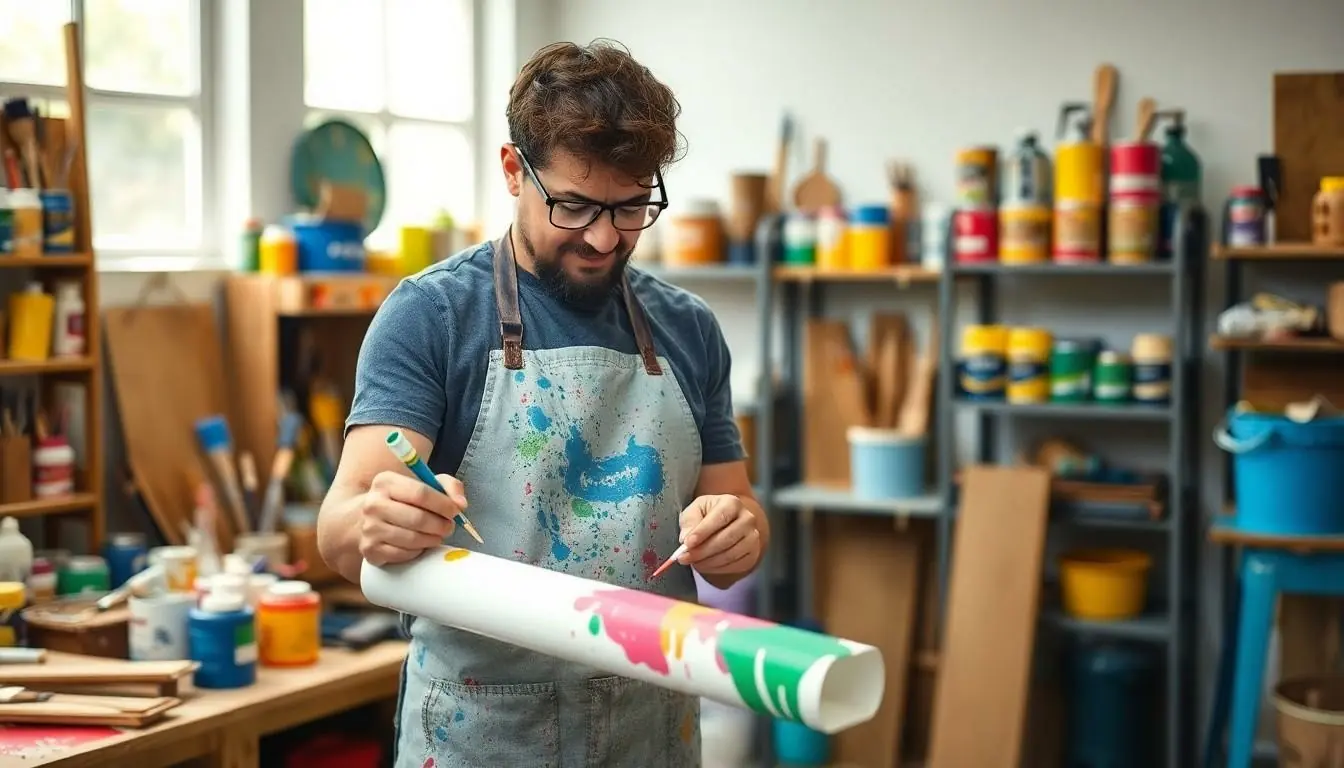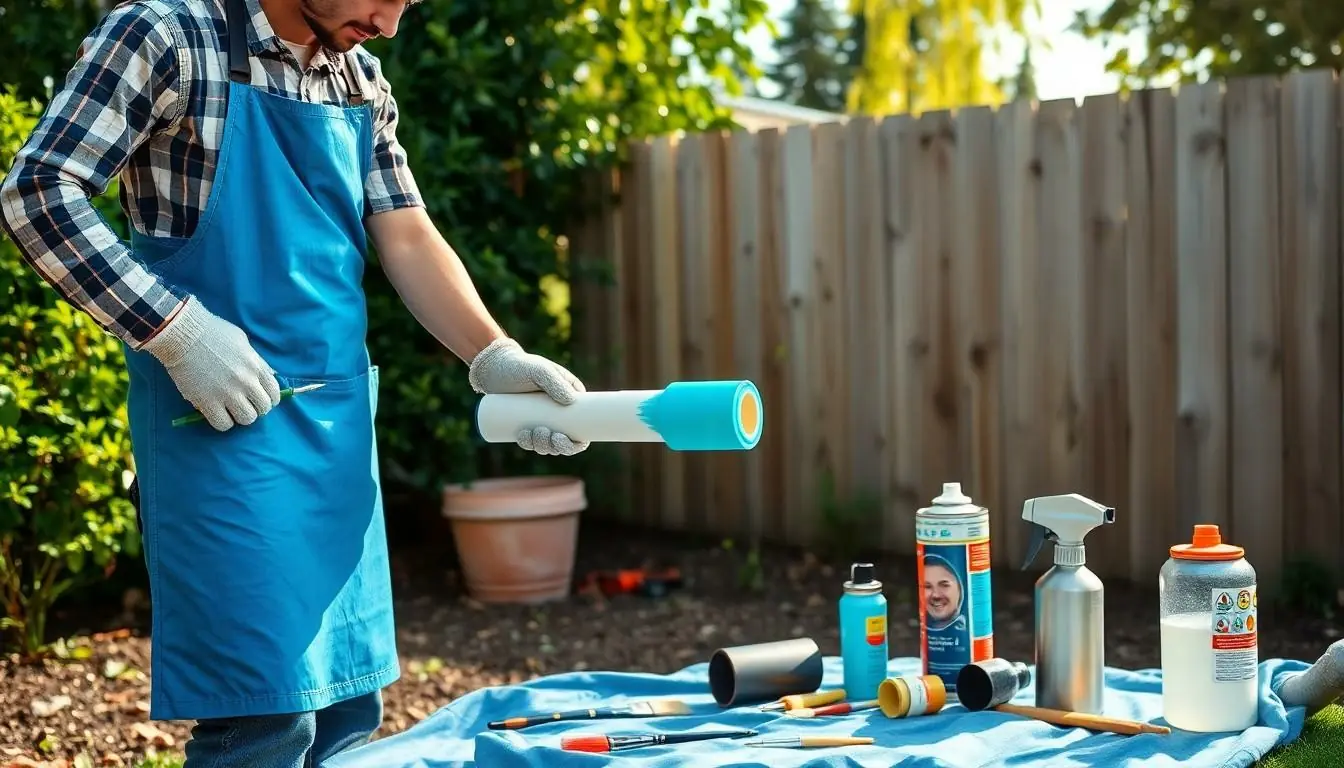Table of Contents
ToggleWhen it comes to home improvement projects, painting PVC might not be the first thing that pops into mind. But why not turn that boring white pipe into a vibrant masterpiece? With a little creativity and the right techniques, those dull PVC surfaces can become eye-catching accents that elevate any space.
Understanding PVC Material
PVC, or polyvinyl chloride, is a versatile synthetic plastic polymer. Its durability and lightweight characteristics make it an ideal choice for various applications.
Properties of PVC
PVC possesses several properties that make it widely favored. It exhibits excellent resistance to moisture, chemicals, and UV rays. This material maintains structural integrity over time and withstands harsh environmental conditions. Furthermore, flexibility enhances its potential for different uses, from plumbing to crafting. Notably, PVC can be produced in multiple colors, though it typically appears in a standard white finish.
Common Uses of PVC
PVC finds extensive utilization in construction and industrial settings. Pipes and fittings often rely on PVC due to its strength and corrosion resistance. Additionally, the material serves in window frames and doors, offering energy efficiency benefits. In the crafting realm, PVC is popular for creating decorative items and signage. Its affordability and availability make it a go-to choice for DIY enthusiasts.
Why Paint PVC?

Painting PVC enhances its appearance and allows for customization. Transforming plain white PVC into colorful accents provides a unique stylistic touch to any space.
Benefits of Painting PVC
Painting PVC offers several advantages. Increased aesthetic appeal distinguishes the material from standard white finishes. Improved weather resistance ensures that colors remain vibrant over time. Added protection against scratches and UV damage maintains both the look and longevity of the PVC. Custom colors match existing decor or project themes, creating a cohesive design. DIY enthusiasts gain an opportunity for creativity, allowing for unique expressions in design projects.
Challenges of Painting PVC
Painting PVC presents certain challenges. Surface preparation requires proper cleaning and sanding for optimal adhesion. Selecting the right primer and paint is crucial; specialized PVC paints are essential for best results. Insufficiently applied coats may lead to flaking or peeling. Weather conditions during painting can impact drying times and finish quality. Requiring maintenance and touch-ups, painted PVC surfaces may not have the same durability as unaltered material.
Preparing PVC for Painting
Preparing PVC surfaces is crucial for achieving optimal results when painting. Proper preparation ensures the paint adheres effectively and creates a lasting finish.
Cleaning the Surface
Cleaning the surface is the first step in preparation. Use a mixture of warm water and mild detergent to remove dirt and grease. Scrubbing the PVC with a soft cloth or sponge helps to eliminate contaminants. Rinse thoroughly with clean water to avoid leaving any soap residue. Allow the surface to dry completely before proceeding. This thorough cleaning process enhances the paint’s adhesion to the PVC.
Sanding and Priming
Sanding the surface provides a rough texture, improving paint adherence. Start with fine-grit sandpaper, gently scuffing the PVC surface. Focus on areas exposed to moisture or wear for better results. After sanding, wipe away any dust with a clean cloth. Priming the surface is the next critical step. Use a primer specifically formulated for plastic materials. A quality primer helps seal the surface and prevents peeling. Apply an even coat, allowing sufficient drying time before painting. This preparation sets the foundation for a durable and vibrant finish.
Choosing the Right Paint for PVC
Selecting the appropriate paint is vital for achieving a successful finish on PVC surfaces. Various types of paint perform better than others due to the unique properties of PVC.
Types of Paint Suitable for PVC
Acrylic latex paint is often recommended for PVC due to its durability and flexibility. Oil-based paint also adheres well to PVC, providing a robust protective layer. Spray paint specifically designed for plastics offers even coverage and quick application. Additionally, specialty paints formulated for outdoor use resist weathering and UV damage. Each type serves different project needs, making it essential to choose based on specific requirements.
Recommended Brands and Products
Popular brands provide high-quality options for painting PVC. Krylon Fusion for Plastic stands out for its excellent adhesion and strong finish. Rust-Oleum Painter’s Touch offers various colors and a smooth application. Valspar and Dupli-Color both produce durable options tailored for plastic surfaces. These products simplify the painting process, ensuring long-lasting results that enhance the aesthetics of PVC fittings, pipes, or decorative items.
Application Techniques for Painting PVC
Different techniques apply when painting PVC surfaces, ensuring optimal results and longevity. Proper tools and equipment enhance the painting experience and final outcome.
Tools and Equipment Needed
Gather essential tools for painting PVC. Choose fine-grit sandpaper to create a suitable surface texture. A high-quality cleaner or detergent aids in removing grease and dirt. Select a brush or roller for larger areas, while spray paint works well for intricate designs. Primer specifically for plastic is crucial for paint adherence. Paint suitable for PVC, such as specialty spray paint or acrylic latex, ensures a vibrant finish. Finally, have painter’s tape available to protect edges and achieve clean lines.
Step-by-Step Painting Process
Follow a structured process for painting PVC. Start by cleaning the surface thoroughly, using warm water and detergent. Rinse and dry the PVC completely to remove any residue. Next, sand the area lightly with fine-grit sandpaper for better adhesion. Wipe away dust with a cloth to prepare for primer application. Apply a plastic primer evenly, allowing it to dry according to product instructions. Once the primer is dry, apply the chosen paint in thin, even coats. Allow adequate drying time between coats for the best results. Finally, inspect the surface for uniform coverage and touch up any areas as necessary.
Painting PVC surfaces opens up a world of creative possibilities for homeowners and DIY enthusiasts alike. With the right preparation and materials, dull white PVC can be transformed into eye-catching accents that enhance any space. The benefits of painting extend beyond aesthetics, offering protection and durability against the elements.
By following the recommended steps and using quality products, anyone can achieve a professional-looking finish. Whether it’s for home improvement or personal expression, painting PVC is a rewarding project that adds character and style. Embracing this versatile material allows for endless customization while maintaining its practicality.




